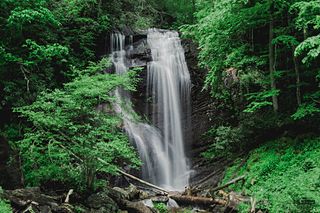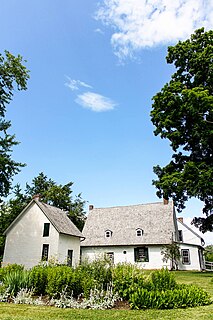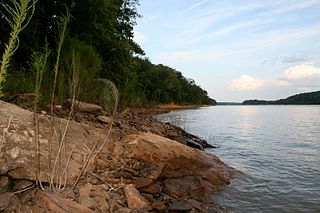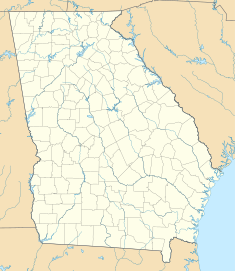
Helen is a city in White County, Georgia, United States, located along the Chattahoochee River. The population was 510 at the 2010 census.

Yonah Mountain is a mountain ridge located in the Chattahoochee-Oconee National Forest in Georgia, United States. It is between the towns of Cleveland and Helen. Yonah is the Cherokee word for Bear.

Sautee Nacoochee is an unincorporated community and census-designated place in White County, Georgia, United States, near Sautee Creek in the Appalachian foothills of northeast Georgia, approximately 95 miles (153 km) north of Atlanta. The nearest incorporated town is the tourist destination of Helen.

Anna Ruby Falls is located near Unicoi State Park in White County near Helen, Georgia. The waterfall is accessible via a half mile paved trail from a public use area with a small admittance charge. The Anna Ruby Falls Trail is designated a National Recreation Trail in Georgia.

George Gustav Heye was an American collector of Native American artifacts in the Western Hemisphere, particularly in North America. He founded the Museum of the American Indian, and his collection became the core of the National Museum of the American Indian.

The Mabee House, on the grounds of the Mabee Farm Historic Site,, is the oldest house still standing in the Mohawk Valley. It is located in the town of Rotterdam, New York, in the hamlet of Rotterdam Junction, New York, along New York State Highway 5S, about six miles (9.7 km) west of the city of Schenectady.

The Villa Louis is a National Historic Landmark located on St. Feriole Island, in Prairie du Chien, southwestern Wisconsin. The villa and estate are a historical museum operated by the Wisconsin Historical Society. The site has been restored to its appearance during the late 19th century, when it was the estate of the prominent H. Louis Dousman family, descendants of a fur trader and entrepreneur.
The Stovall Mill Covered Bridge is the smallest covered bridge in Georgia. Built in 1895, it is one-lane wide, 33 feet long, and made of wood. It spans Chickamauga Creek in White County and is located near State Route 255.

Tugaloo was a Cherokee town located on the Tugaloo River, at the mouth of Toccoa Creek. It was south of Toccoa and Travelers Rest State Historic Site in present-day Stephens County, Georgia. Cultures of ancient indigenous peoples had occupied this area, and those of the South Appalachian Mississippian culture built a platform mound and village here. It was an administrative and ceremonial center for them.

The Sautee Valley Historic District comprises the southern half of the Sautee Valley, near Sautee, Georgia. Lynch Mountain is to the southeast, Grimes Nose is to the northwest, and the Nacoochee Valley is to the southwest. There are historic and prehistoric resources, mostly along the edges of the valley. Historic structures include houses, farms, stores, and other typical buildings dating from the 19th and early 20th centuries. Prehistoric resources include ceremonial and settlement sites and feature Nacoochee Mound, an earthwork platform mound on the banks of the Chattahoochee River. This area is adjacent to the Nacoochee Valley Historic District. The historic district was added to the National Register of Historic Places in 1986.

The Nacoochee Valley Historic District is in White County, Georgia. The valley is enclosed by Mount Yonah, and Sal Mountain. Manmade objects in the valley span centuries. The most obvious Native American artifact is the Nacoochee Mound at the western edge of the valley, which is 17 feet tall and 70 feet in diameter. There are structures throughout the district since the settlement of European people in the 1820s. The Richardson-Lumsden house and the Williams-Dyer Residence date from the early period of settlement by European people. The most elaborate structure is the Nichols-Hunnicutt-Hardman House. The area was added to the National Register of Historic Places in 1980. It is adjacent to the Sautee Valley Historic District.
The Ruby and Elizabeth Cohen Woodlands is a park located on McDonald Road in Colchester, Connecticut. This park consists of 121 acres (0.49 km2) of natural space and includes such facilities as a gazebo, picnic tables, and hiking trails. There are two ponds on the property in addition to marshland.
George Hubbard Pepper was an American ethnologist and archaeologist. He worked on projects in New York, the Southwest and, most notably, the Nacoochee Mound in northeastern Georgia. His work with Frederick W. Hodge was sponsored by the Heye Foundation, Museum of the American Indian, and the Bureau of American Ethnology

The Nacoochee Mound is an archaeological site on the banks of the Chattahoochee River in White County, in the northeast part of the U.S. state of Georgia. Georgia State Route 17 and Georgia State Route 75 have a junction near here.

Rose Hill Manor, now known as Rose Hill Manor Park & Children's Museum, is a historic home located at Frederick, Frederick County, Maryland. It is a 2+1⁄2-story brick house. A notable feature is the large two-story pedimented portico supported by fluted Doric columns on the first floor and Ionic columns on the balustraded second floor. It was the retirement home of Thomas Johnson (1732–1819), the first elected governor of the State of Maryland and Associate Justice of the United States Supreme Court. It was built in the mid-1790s by his daughter and son-in-law.

Northeast Georgia is a region of Georgia in the United States. The northern part is also in the north Georgia mountains, while the southern part is still hilly but much flatter in topography. Northeast Georgia is also served by the Asheville/Spartanburg/Greenville/Anderson market.

The Wolcott Mill is a grist and feed mill located at 63841 Wolcott Road in Ray Township, Michigan. It was listed on the National Register of Historic Places in 2009.

The Kenimer Site is an archaeological site near Sautee Nacoochee, Georgia in White County. The site contains two earthwork mounds located on top of a natural hilltop.

Burrland Farm Historic District is a historic home and farm complex and national historic district located near Middleburg, Fauquier County, Virginia. The district encompasses 22 contributing buildings, 2 contributing sites, 14 contributing structures, and 1 contributing object on a 458-acre thoroughbred horse breeding and training farm. The buildings were built between 1927 and 1932, and include a Georgian Revival style training barn, a polo barn, a stallion barn, two broodmare barns, a yearling barn, a field shed, an equipment shed, a farm manager's house / office, a trainer's cottage, a mess hall quarters, a foreman's dwelling, three mash houses, five garages, a pumphouse, and a feed and storage warehouse. The contributing structures include a silo, a springhouse, three loading chutes, two teasing chutes, two rings, three run-in sheds, one sun hut and an entrance gate. The original Burrland house was built in 1879 and expanded in 1927 for William Ziegler Jr. by architect William Lawrence Bottomley. Ziegler sold the property in 1955 to Eleonora Sears, who "deliberately gutted and burned [the mansion] down" in 1961. She then sold the farm in 1966.

Too-Cowee, was an important historic Cherokee town located near the Little Tennessee River north of present-day Franklin, North Carolina. It also had a prehistoric platform mound and earlier village built by ancestral peoples. As their expression of public architecture, the Cherokee built a townhouse on top of the mound. It was the place for their community gatherings in their highly decentralized society. The name translates to "pig fat" in English. British traders and colonists referred to Cowee as one of the Cherokee Middle Towns along this river; they defined geographic groupings based in relation to their coastal settlements, such as Charlestown, South Carolina.
















